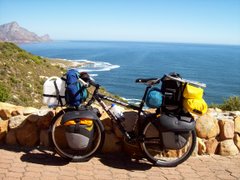




The town of Baños (where I ended my last report) is already a fair way up between the Amazon Basin and the Central Highlands of Ecuador, and as the three of us cycled onwards we were entertained by views of the smoking vulcano which we were leaving behind (Phillip and Isa had gone ahead the previous day). As we moved North the road took us past a number of other high mountains, mostly vulcanos. One of the mountains we passed is the extinct Vulcan Chimborazo, and at well over 6000 metres above sea level it is the highest mountain in Ecuador (and due to the equatorial bulge it's summit is the furthest point from the centre of the earth). However, the second-highest mountain, Vulcan Cotopaxi, is by far the most spectacular (and at nearly 6000 m it is apparently the highest active vulcano in the world). Therefore we made a diversion off the paved roads into the Cotapaxi National Park. Once again, with my narrow pavement tyres I had lots of "fun" climbing up the rather poor gravel road into the Park where we camped at an altitude of close to 4000 m (fortunately there was a hut in which we could camp, as there was a freezing wind blowing). We were very fortunate that the day was perfect with blue sky, so I took about a million photo's of that mountain. The following morning was also OK, but soon the clouds rolled in again, obscuring most of the vulcano as we looked back. On that day we had to descend down towards the Pan Americana again, firstly on a terrible gravel road, and then for about 10 km on a slippery uneven cobblestone "Big Dipper" (even though I was constantly on the brakes I still suffered a broken spoke). Then it was Northwards on the Pan Am highway, and now eventually I've arrived in the capital of Ecuador, Quito. There is a new part to the city, but the Old Historic Centre is quite wonderful to see. For the past few days Hannes, Annelies and myself have been staying in the new Casa De Cyclistas in the new part of town, where we met up with Phillip and Isa again. We'll probably move on tomorrow to another Casa De Cyclistas a few k's outside Quito, and stay there for a couple of days before heading North to the equator about 20 km away. Daily distances cycled since Cuenca have been:- Palmas 82 km; Mt Camp 60 km; Mendez 42 km; Macas 79 km; Puente Pastaza 66 km; Puyo 69 km; Baños 62 km; Pillaro 47 km; Laso 58 km; Cotapaxi NP 28 km; Machachi 39 km; and Quito 44 km. The total distance cycled in South America so far is 16 964 km, and the total distance which I've cycled so far on this journey is 83 451 km.


























